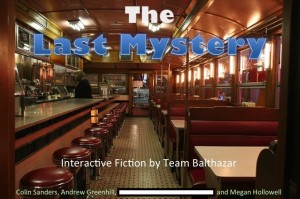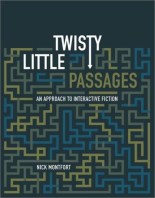In two earlier posts in this series, I gave an overview of why I use interactive fiction games in my composition classes, and described an “easy way” to do this: that is, using these games as “the reading” for a course unit. If you’re just joining us and you want to get a quick idea of what interactive fiction (or “IF”) is, the fastest way might be to go here and play a tutorial game (Andrew Plotkin’s The Dreamhold) for yourself. If you’re new to the genre, playing these games can take a little bit of getting used to. In the present post, I describe an assignment that takes even more getting used to: writing IF games.
Using Interactive Fiction in Your Classroom, the Hard Way: Games as Composition Assignments
 In my class, writing an IF game is usually the final major project, assigned after the students have already played several published games and completed a range of short coding projects in Inform 7 (the “natural English” programming language I’ve used). Here’s the core of the assignment:
In my class, writing an IF game is usually the final major project, assigned after the students have already played several published games and completed a range of short coding projects in Inform 7 (the “natural English” programming language I’ve used). Here’s the core of the assignment:
Team IF Assignment: Make Your Own Game
Our course culminates in the design, writing, programming, playtesting, and revision of our own interactive fiction computer games. Your team of 4 or 5 authors will spend the next month creating a short IF game of publishable quality. Our purposes in this assignment include:
- learning how to suggest, anticipate, and plan for a range of audience responses, and learning how to deal with unexpected responses
- exploring synergies between game design and rhetorical design
- interrogating concepts of authorship, readership, character, interpretation, and meaning
- understanding and learning to use the discourses surrounding interactive texts and electronic texts
- learning to design with multimodal synergy (weaving together written, oral, visual, electronic, and nonverbal elements in the rhetoric of a single text)
It is vital for your game to work as a game; that is, it should be an engaging (or even entertaining) interactive experience for the player. Even more important, however, is the rhetorical project that will drive each game; you should attempt to persuade your audience of something very specific, some central claim or thesis. To the player, your game’s argument may be explicit, implicit, or somewhere in between; but take care not to lose sight of it, as my evaluation will focus primarily on the success of your rhetoric. In other words, engaging and entertaining the player should be means to a particular rhetorical end.
Pay attention to detail. I would much rather play a small, intricate, polished, thoroughly playtested game than a sprawling, uneven mess, however ambitious. The overall amount of well-polished writing should be a few thousand words, and you should definitely include at least five larger chunks of text (say, 400 words or more) that will stick in the player’s mind. Though your game’s primary modes will be the written and the electronic, think about how you might use the image, sound, and hyperlink-to-video capabilities of the interpreter; you should employ at least two of these.
A complete and playable rough draft (for your peers’ playtesting, as well as my feedback) will be due a week and a half before the final draft. Both rough and final drafts must include:
- the game file itself
- your complete source code
- a “title page” image
- a complete walkthrough
You will probably incorporate the title page image and the walkthrough into the actual game file, but please also submit them separately.
Happy game-making!
As you can see, it’s important to keep the focus of each game appropriately rhetorical; this is, after all, a composition class. I don’t want to compel each team to beat the player over the head with its “thesis,” but the persuasive element does have to be there. That doesn’t mean I steer my students toward essay-like games, though. Most of my students choose to write literary and/or fictional games, and in fact I tell them that it’s possible for a literary work to persuade even more effectively than the most persuasive essay. This advice works especially well in Georgia Tech’s English 1102 class, which teaches composition through literary texts.
The institutional context of this assignment lets me do certain things I couldn’t do elsewhere. I assign it to three classes of 23 or so Georgia Tech freshmen. At Tech, all students are required(/privileged) to own laptops, and most of them have (or are expected to acquire) at least some programming experience. Moreover, there are usually some genuinely expert coders and even professional game designers among their ranks. If/when I have the chance to teach an IF writing assignment at another college or university, I suspect that I’ll make it less programming-heavy by replacing Inform 7 with Twine, a program that I’ll discuss further below. As it is, though, I’m lucky enough to teach a large group of students who are willing and able to work with code both in and out of the classroom.
Having a large group actually makes the assignment easier, because my three sections can collaboratively build and maintain an extensive blog section meant for coding difficulties and challenges. When one team runs into a problem, they can just post it to the blog, where another team (or their instructor) can help solve the challenge for them. As I tell my students, they don’t have to start from scratch or slog through every chapter of the Inform 7 programming handbook; instead, they can develop bits and pieces of expertise, and take advantage of others’ bits and pieces, on their way toward a collaborative mastery that is larger than the sum of its parts.
Tightly organized teamwork is obviously important to this sort of project, so I use a web survey to help each team find a good mix of skills (not just coding, but also organization, writing, and other design modes), and to make sure that the team members’ individual visions will complement each other. I ask each student to say what he or she is good at, then distribute the survey results to the class and let them form their own groups using that data, reserving my right to adjust the teams if I see a need. For a project like this, it’s worth spending some extra time on group organization.
What IF Games Can Do: Digital Pedagogy and the Interactive Form
The assignment purposes that I’ve listed above are fairly abstract, so let’s take a look at an example of a student-written game.
 “Team Balthazar” (Colin Sanders, Andrew Greenhill, Megan Hollowell, and two students who preferred to remain anonymous) wrote this game, The Last Mystery, in my English 1102 course in the spring of 2013. (Requiring team names helps forge group bonds and rivalries, in addition to making organization easier for the instructor.) Mystery is notable not only for its polish (clear writing, expert coding, subtle rhetorical methods, fluid integration of words with images and sounds) but also for its intellectual experimentalism. This is a good example of how an IF composition assignment can really stretch students’ minds, and how they can stretch the possibilities of the genre in return. Click here or on the picture to watch a “Let’s Play“-style video of a player’s experience, overlaid with my audio commentary, as we suddenly find ourselves in the shoes of a hard-boiled veteran detective, paying a visit to his favorite diner under unusual circumstances: “This is it. One final mystery, and you can retire. You’ve been offered such a large sum of money, it’s almost too good to be true. So here you are….”
“Team Balthazar” (Colin Sanders, Andrew Greenhill, Megan Hollowell, and two students who preferred to remain anonymous) wrote this game, The Last Mystery, in my English 1102 course in the spring of 2013. (Requiring team names helps forge group bonds and rivalries, in addition to making organization easier for the instructor.) Mystery is notable not only for its polish (clear writing, expert coding, subtle rhetorical methods, fluid integration of words with images and sounds) but also for its intellectual experimentalism. This is a good example of how an IF composition assignment can really stretch students’ minds, and how they can stretch the possibilities of the genre in return. Click here or on the picture to watch a “Let’s Play“-style video of a player’s experience, overlaid with my audio commentary, as we suddenly find ourselves in the shoes of a hard-boiled veteran detective, paying a visit to his favorite diner under unusual circumstances: “This is it. One final mystery, and you can retire. You’ve been offered such a large sum of money, it’s almost too good to be true. So here you are….”
The video, at 17 minutes, is rather longer than I intended (I went on a bit), so I’ll recap a few important points here just in case you don’t have a chance to watch the whole thing:
- Authoring IF games lets students play with concepts of authorship, readership, and character. In IF, the boundaries between these categories can wobble or collapse, as the player must read the text of the game, write what he/she wants to do next, and live in the shoes of the viewpoint character (whom the game addresses as “you”) in order to move the story along. In The Last Mystery, the player’s identification with the detective protagonist is crucial to the game’s rhetorical project. The authors use the game to make a bold claim about the relationship between sanity and memory, and because the player and detective are simultaneously fighting to figure out the nature of the storyworld (and the nature of consciousness) the game can persuade the player of its claim much more organically.
- IF allows students to weave together different modes with greater sophistication and care than most other genres, especially because different players may encounter the game’s words, images, and sounds in different orders. In Mystery, the central puzzle of the game (and its rhetorical impact) depends on the player noticing an eerie and variable connection between the songs playing on a jukebox and the images in an ever-changing painting; the player must then deduce the precise nature of the connection and accept his/her own immersion in the text in order to proceed. Mystery‘s authors had to carefully manage this immersion by crafting subtle links between the various modes.
- Writing and revising IF is excellent training for anticipating a wide range of audience responses to a text. A writing-center tutor is sometimes trained to think aloud while reading a student essay, giving its author direct feedback on how his/her words are being interpreted. Transcripts of IF playtesting sessions serve the same purpose. Because a player’s progress may stall if the author hasn’t adequately provoked and managed a wide range of responses, authors are driven constantly to put themselves in the player’s shoes, ensuring that both parties stay on the same page. Furthermore, the variety of possible pathways in an IF game invites students to consider their own rhetorical moves in other contexts as more naturally interactive, able to anticipate and provoke different responses from different readers. Mystery encourages multiple paths, solutions, and sequences of events, making sure that nearly everything a player might think to try is implemented.
Tips for Teachers
If you’re planning on running a group assignment in your class, you’ll need to drill into your students’ heads the necessity of active, well-organized collaboration. The labor of creating an IF game can be tough to divvy up neatly. Because any change in one element of the game — character, plot, object descriptions, narrative voice — might have repercussions on several others, each group must develop and enforce (with your judicious assistance) systems for drafting, collating, revising, and testing each other’s work. At least one collaborative spreadsheet (kept on Google Docs, for example) is a necessity for scheduling, and a group might use several more to keep track of the bits and pieces of the project.
(I think, though, that this intensive and detailed group work is a feature, not a bug, of the assignment. Because each scrap of writing must pass through multiple hands (and multiple drafts of code), the students pay extra attention to polishing their work and to ensuring a hearing for their game’s message. Too, the students end up attending more closely to the interplay and synergy between modes, as Ali’s scenic descriptions will rely heavily on Britney’s illustrations, and so forth. Moreover, the cyclical process of IF programming (add content, test the code, revise, repeat) ensures that students will read their own work over and over, a good habit that can be difficult to promote in more traditional composition assignments.)
Over the course of the semester, I ask each member of a team to play a variety of IF games, letting them discover some weaknesses to avoid and strengths to build on in other authors’ work. For instance, I assign the classic game Zork I to one student, so he can share his knowledge of IF’s puzzle-centric roots; while I give to another member Adam Cadre’s 9:05, so she can explain how a short, sharp shock of a game can pack more punch than a long adventure. I ask students to research subgenres of IF on their own, and to learn about the puzzle types they contain. I assign reading and viewing that contextualizes what they’re learning: Ian Bogost on procedural rhetoric, and Nick Montfort on the theory and vocabulary used by IF scholars. I encourage students to talk to active members of the worldwide IF scene.
This project does require a lot of coding, and I do worry about this, especially as I prepare to move to a different institution next year. My three final tips are all ways of reducing the coding burden:
- When it comes to the scale of the games, encourage your students to think small! A very few locations, characters, and objects, if sufficiently detailed and interactive, are enough to carry a gorgeous and effective game. In the heady days of brainstorming for the project, students tend to envision something like Skyrim. I recommend a one-room game like Jeremy Freese’s Violet to show them just how extensive a “small” interactive text can be.
- Take advantage of coding shortcuts. Get students to use the Inform Recipe Book (included with the Inform 7 program), rather than coding everything from scratch. Ask them to find games with publicly available source code and borrow their authors’ methods.
- Use Twine instead of Inform 7. Here’s an example of a Twine game, Porpentine’s Howling Dogs. As you can see, it’s richly interactive — much more so than a bare-bones Choose Your Own Adventure model — but there’s no command prompt. The blank command prompt, with its invitation for a player to type language of his/her own — to co-author the story more actively — is what I like best about the genre, so I’m loath to give it up. Nevertheless, I’m thinking of giving my current students a choice between the two systems, perhaps assigning the Twine authors an extra wing of the project (a Let’s Play video of their own game, perhaps) to even out the workload.
The Adventure Continues
In Part Four of this series, coming up in a few months, I plan to discuss the successes and failures of an IF assignment from my current (Fall 2014) English 1102 class on “Performing English Renaissance Drama.” That assignment will have a more specific focus than the one above. I’ll ask my students to investigate emotion, affect, and interior/exterior selfhood — and also to examine the boundaries between dialogue, monologue, and audience aside — by writing IF “remixes” of early modern plays. This time around, I’m going to make sure at least a few teams release their games to the public, so you’ll be able to play them yourself! I’m also planning to expand this work into a journal article; stay tuned.
[A special note for my Brittain Fellow colleagues in the Writing and Communication Program here at Tech: all the necessary software for experimenting with IF is installed on the workstations in our DevLab, so do play around with the genre and let me know what you think, especially if you see an opportunity for collaboration!]
In the meantime, I’d love to read and respond to any of your comments or questions, especially if you’ve taught or plan to teach IF. Comments on this article will close after a while, but please do hit me up using the below contact information anytime.
About the author: A Brittain Fellow since 2012, Jonathan Kotchian (PhD and MA in English, University of Connecticut; BA in theater, Yale University) is revising his first book project, which shows how the figure of the superior author in early modern England co-evolved with satire. His second book project, which continues his investigation of “insider” literature accessible only to certain readers or viewers, explores the relationship between concepts of intelligence and literary taste. His interests range from Shakespeare and Milton to using theatrical training techniques in the multimodal composition classroom, where he asks his students to foreground their own motivations, self-presentations, and affective responses. Key interests: early modern literature, composition, authorship, satire, intelligence, drama, theater, interactive fiction games, and digital humanities. He can be reached by e-mail at jonathan.kotchian@lmc.gatech.edu or jkotchian@yahoo.com, and via Twitter @JonKotchian.


